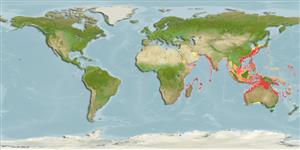Common names from other countries
Environment: milieu / climate zone / depth range / distribution range
Écologie
marin récifal; profondeur 1 - 150 m (Ref. 9710). Subtropical; 36°N - 36°S, 23°E - 175°E (Ref. 5222)
Indo-West Pacific: East Africa to the western Pacific, southward into temperate waters of South Africa, Australia, and New Zealand. Not known from the Red Sea or Persian Gulf.
Length at first maturity / Taille / Poids / Âge
Maturity: Lm 19.4, range 14 - ? cm
Max length : 45.0 cm TL mâle / non sexé; (Ref. 90102); poids max. publié: 1.4 kg (Ref. 5222)
Épines dorsales (Total): 11; Rayons mous dorsaux (Total): 16-18; Épines anales 3; Rayons mous anaux: 8. Characterized by red-brown head; body mottled pale-brown color; 5-6 irregular dark brown bars on body; caudal fin dark brown with pale speckling; body scales ctenoid except cycloid anterodorsally above lateral line, on nape, thorax and abdomen; body with auxiliary scales only anterodorsally behind zone of small cycloid scales; greatest depth of body; 2.7-3.2 in SL; rounded caudal fin; pelvic fins, 1.9-2.4 in head length (Ref. 90102); body depth contained 2.7-3.2 times in SL; head length 2.3-2.6 times in SL; head length 2.3-2.6 times in SL; flat to slightly convex interorbital area, dorsal head profile convex; snout length 4.0-5.0 in HL; angular preopercle, with enlarged serrae at angle; straight upper edge of operculum, almost horizontal; posterior and anterior nostril subequal in size; maxilla reaches to or past vertical at rear edge of eye, ventral edge with slight step at distal expansion; 2-3 rows of teeth on midlateral part of lower jaw; pyloric caeca (Ref. 89707).
Sedentary reef-associated species (Ref. 89707). Occurs on coral reefs, areas with rocky substrata, algal flats and seagrass beds. Feeds on fishes and crustaceans (Ref. 30573). A protogynous hermaphrodite (Ref. 55367). Forms spawning aggregations (Ref. 55367). Solitary (Ref 90102).
Life cycle and mating behavior
Maturité | Reproduction | Frai | Œufs | Fécondité | Larves
A monandric species (Ref. 55367). Length at sex change = 75.6 cm TL (Ref. 55367).
Heemstra, P.C. and J.E. Randall, 1993. FAO Species Catalogue. Vol. 16. Groupers of the world (family Serranidae, subfamily Epinephelinae). An annotated and illustrated catalogue of the grouper, rockcod, hind, coral grouper and lyretail species known to date. Rome: FAO. FAO Fish. Synop. 125(16):382 p. (Ref. 5222)
Statut dans la liste rouge de l'IUCN (Ref. 130435)
CITES (Ref. 128078)
Not Evaluated
Menace pour l'homme
Harmless
Utilisations par l'homme
Pêcheries: intérêt commercial mineur
Plus d'informations
RéférencesAquacultureProfil d'aquacultureSouchesGénétiqueElectrophoresesHéritabilitéPathologiesTraitementMass conversion
Outils
Articles particuliers
Télécharger en XML
Sources Internet
Estimates based on models
Preferred temperature (Ref.
115969): 21.5 - 28.8, mean 27.2 (based on 1542 cells).
Phylogenetic diversity index (Ref.
82804): PD
50 = 0.5000 [Uniqueness, from 0.5 = low to 2.0 = high].
Bayesian length-weight: a=0.01259 (0.00794 - 0.01995), b=3.03 (2.90 - 3.16), in cm Total Length, based on LWR estimates for this species & Genus-body shape (Ref.
93245).
Niveau trophique (Ref.
69278): 3.6 ±0.54 se; based on food items.
Résilience (Ref.
120179): Haut, temps minimum de doublement de population inférieur à 15 mois (K=0.4).
Fishing Vulnerability (Ref.
59153): Low to moderate vulnerability (32 of 100).
